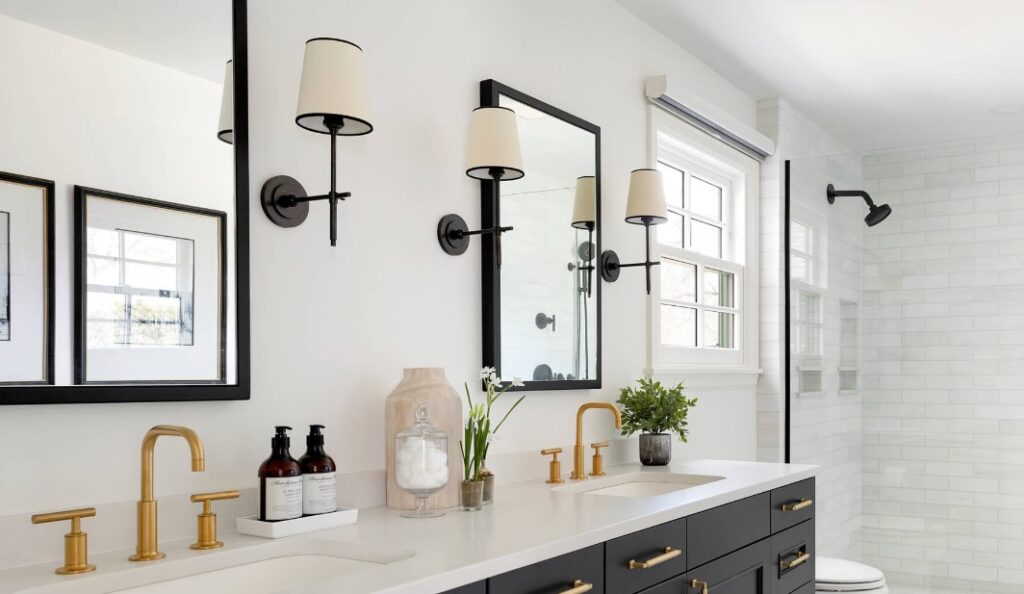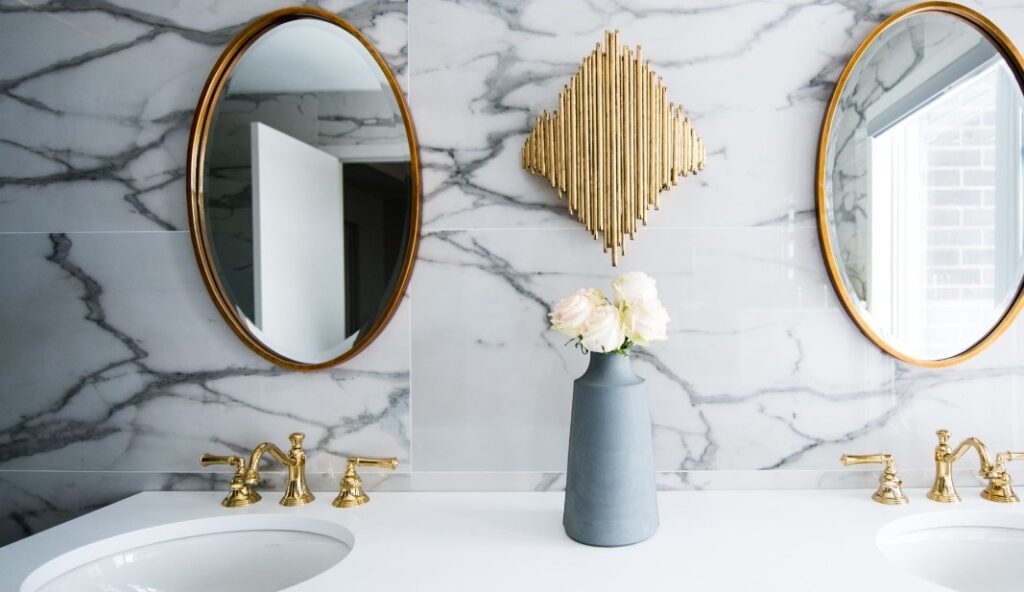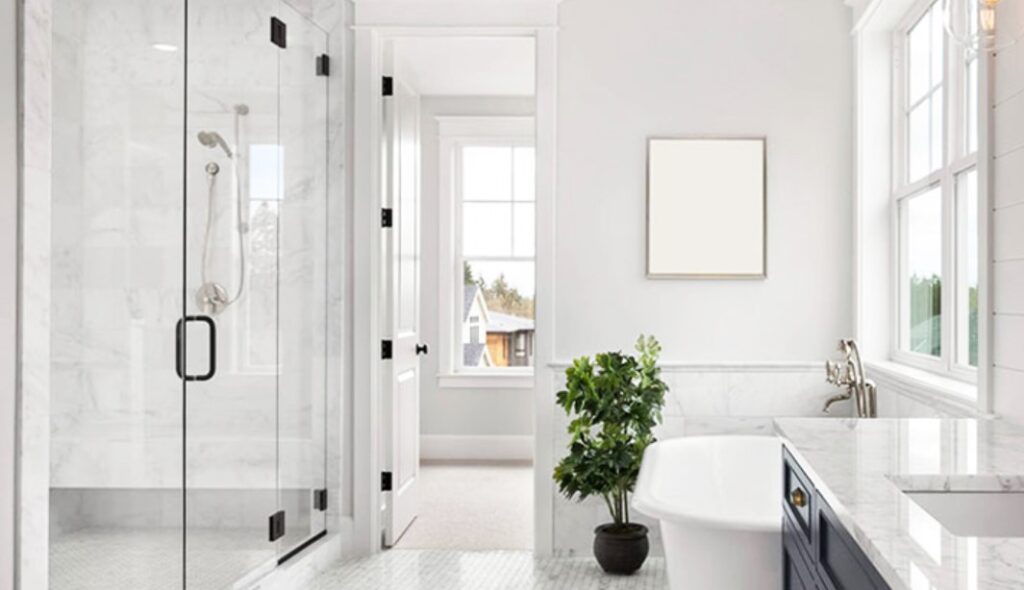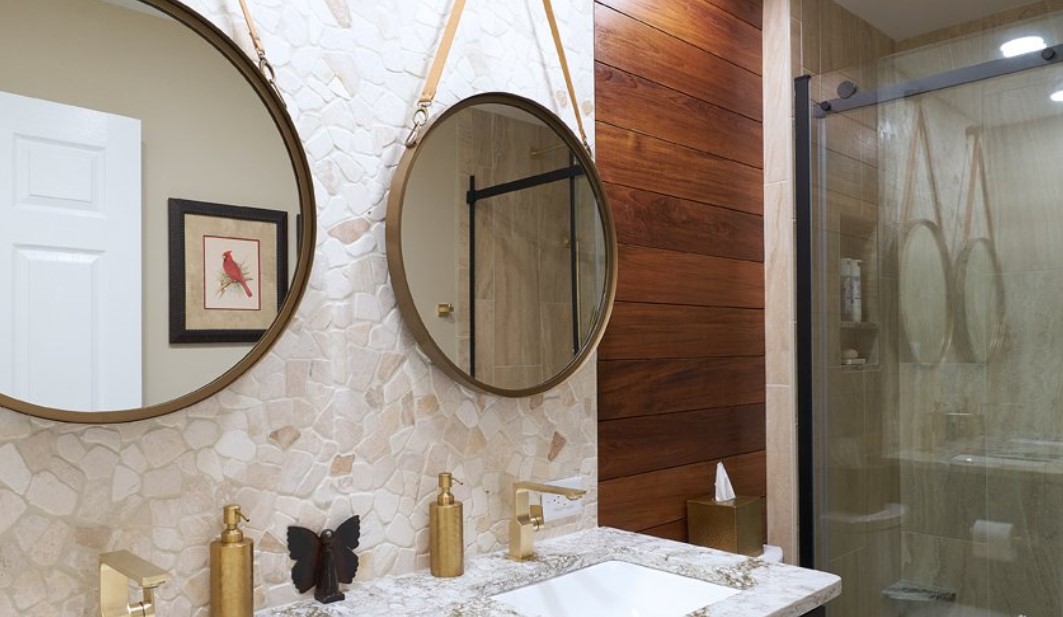Remodeling a small bathroom can be a rewarding yet challenging task. With the right design strategies, you can maximize space, functionality, and style. Whether you’re looking to create a spa-like retreat or simply make better use of the available space, here are some innovative ideas to inspire your small bathroom remodel.
Maximize Space with Smart Storage Solutions

Floating Vanities
A floating vanity can make a small bathroom feel more spacious by freeing up floor space and creating an open, airy feel. Choose a vanity with built-in storage to keep toiletries and other essentials neatly organized. This modern design element not only adds style but also improves the overall functionality of the bathroom.
Recessed Shelving
Installing recessed shelves in the shower or above the sink can provide valuable storage without taking up additional space. These built-in shelves offer a sleek, streamlined look while keeping bath products within easy reach. Consider adding a recessed medicine cabinet to maximize wall space further.
Over-the-Toilet Storage
Utilize the often-overlooked space above the toilet by installing shelves or cabinets. This area is perfect for storing extra towels, toiletries, and decorative items. Choose open shelving for a light, airy look, or opt for closed cabinets to keep things tidy and out of sight.
Enhance Light and Brightness

Light Colors and Reflective Surfaces
Using light colors on walls, floors, and fixtures can make a small bathroom feel larger and more open. Whites, creams, pastels, and light grays are excellent choices. Reflective surfaces, such as glossy tiles, mirrors, and glass, can also help bounce light around the room, enhancing brightness and creating the illusion of more space.
Large Mirrors
A large mirror can visually expand a small bathroom. Consider a wall-to-wall mirror above the vanity or a floor-to-ceiling mirror on one wall. Mirrors reflect light and create a sense of depth, making the room feel more spacious. Adding a backlit mirror can also provide functional, flattering lighting.
Natural Light
Maximize natural light by keeping window treatments minimal. Sheer curtains or frosted glass can provide privacy while allowing light to filter through. If possible, consider installing a skylight or solar tube to bring additional natural light into the bathroom.
Opt for Space-Saving Fixtures

Compact Toilets and Sinks
Choose compact fixtures that are scaled appropriately for a small bathroom. Wall-mounted toilets and sinks can save valuable floor space and create a sleek, modern look. Pedestal sinks are another good option, offering a classic design while occupying minimal space.
Corner Sinks and Toilets
Installing a corner sink or toilet can make efficient use of awkward spaces and free up more room for movement. Corner fixtures are designed to fit snugly into corners, maximizing floor space and providing a functional solution for small bathrooms.
Walk-In Showers
A walk-in shower with a frameless glass enclosure can make a small bathroom feel more open and spacious. Opt for a curbless design to create a seamless transition between the shower and the rest of the bathroom. Consider using clear glass to keep the space visually open.
Incorporate Multi-Functional Elements

Designing a small bathroom requires creative thinking to maximize space and functionality. Incorporating multi-functional elements not only saves space but also enhances the usability and style of the bathroom. Here are some innovative ideas to help you make the most of your small bathroom with multi-functional elements.
1. Shower-Tub Combo
A shower-tub combo is a classic multi-functional element that combines the convenience of a shower with the luxury of a bathtub. In a small bathroom, this dual-purpose fixture saves space by eliminating the need for separate shower and tub units. Opt for a sleek, modern design with a glass enclosure to maintain an open and airy feel. This versatile setup is perfect for families or individuals who enjoy both quick showers and relaxing baths without compromising on space.
2. Built-In Storage Niches
Built-in storage niches in the shower area or next to the bathtub are practical multi-functional elements that provide convenient storage for bath essentials. These niches can be seamlessly integrated into the wall tiles or shower surround, eliminating the need for bulky shelves or cabinets that take up valuable floor space. Consider adding multiple niches at varying heights to accommodate different items, from shampoo bottles to decorative accents, while keeping the bathroom organized and clutter-free.
3. Fold-Down Bench
A fold-down bench in the shower is an excellent multi-functional addition for small bathrooms, offering seating when needed and folding away when not in use. This space-saving solution is ideal for elderly individuals or those with limited mobility who may benefit from a resting spot during showering. Look for benches made from waterproof and rust-resistant materials to ensure durability and safety in wet environments. When not in use, the bench blends seamlessly into the shower design, maintaining a streamlined appearance.
4. Vanity with Built-In Storage
Opt for a vanity with built-in storage to maximize space efficiency in a small bathroom. Choose a compact yet functional design that includes drawers, shelves, or cabinets for storing toiletries, towels, and other bathroom essentials. A floating vanity can further enhance the sense of space by freeing up floor area and creating a visually open environment. Consider integrating organizers or dividers within the drawers to maximize storage capacity and keep items neatly organized and easily accessible.
5. Mirror Cabinet
A mirror cabinet combines the functionality of a mirror with the storage capacity of a cabinet, making it a valuable multi-functional element for small bathrooms. These cabinets can be recessed into the wall above the vanity or installed as a surface-mounted unit, providing storage space for medications, skincare products, and other small items. Choose a mirrored front to reflect light and create a sense of depth, enhancing the overall brightness and spaciousness of the bathroom. Some mirror cabinets also feature integrated lighting, adding both practicality and style to the space.
6. Towel Bars with Shelf
Install towel bars with shelves to maximize vertical space and provide additional storage in a small bathroom. These multi-functional fixtures allow you to hang towels while utilizing the shelf space for storing toiletries, decorative accents, or extra linens. Choose a design that complements your bathroom decor and offers sufficient space for both hanging and shelving needs. Position the towel bars strategically near the shower or bathtub for easy access to towels after bathing, enhancing convenience and functionality.
7. Wall-Mounted Toilet
A wall-mounted toilet is an innovative multi-functional element that helps save floor space and creates a sleek, modern look in small bathrooms. These toilets are mounted directly onto the bathroom wall, with the tank hidden behind the wall for a clean and minimalist appearance. Wall-mounted toilets are not only space-efficient but also easier to clean and maintain compared to traditional floor-mounted models. This design choice can contribute to a more open and spacious feel in the bathroom while optimizing functionality and style.
Incorporating multi-functional elements is essential for maximizing space and enhancing usability in a small bathroom. Whether you choose a shower-tub combo, built-in storage niches, a fold-down bench, or other innovative solutions like vanity with built-in storage and mirror cabinets, these elements can transform your small bathroom into a functional and stylish oasis. Embrace these ideas to create a bathroom that meets your needs for comfort, organization, and aesthetic appeal, making the most of every inch of space available.
Choose the Right Flooring and Wall Treatments
Choosing the perfect flooring and wall treatments for your home goes beyond mere aesthetics; it’s about creating spaces that are functional, durable, and visually appealing. Whether you’re renovating or building anew, the decisions you make regarding these elements can significantly impact the ambiance and value of your home. Let’s explore how to navigate these choices effectively.
Introduction to Flooring and Wall Treatments
When it comes to home decor, flooring and wall treatments play crucial roles. They set the tone for each room, affecting everything from comfort to maintenance requirements. Opting for the right materials involves considering various factors, ensuring that your choices align with both practical needs and aesthetic preferences.
Factors to Consider When Choosing Flooring
Durability and Maintenance
One of the primary considerations when selecting flooring is durability. Different areas of your home will have varying levels of foot traffic, so it’s essential to choose materials that can withstand daily wear and tear. Additionally, consider the maintenance requirements; some materials may require more upkeep than others.
Style and Design Preferences
Flooring contributes significantly to the overall style of your home. Whether you prefer a rustic look with hardwood or a modern vibe with sleek laminate, your flooring choice should complement the existing decor and reflect your personal taste.
Budget Considerations
Budget is another critical factor. While hardwood flooring may be luxurious, it comes with a higher price tag compared to more economical options like vinyl or laminate. Determine your budget early on to narrow down your choices effectively.
Types of Flooring Materials
- Hardwood Flooring: Hardwood flooring is renowned for its timeless appeal and durability. It offers a natural warmth and elegance to any room. However, it can be prone to scratches and requires periodic maintenance to preserve its beauty.
- Benefits and Drawbacks: Hardwood flooring adds value to your home and can last for decades with proper care. However, it is susceptible to moisture and may not be suitable for areas prone to spills.
- Popular Wood Types: From oak to maple and cherry, each wood type offers unique grains and colors, allowing you to customize your flooring to match your decor.
Laminate Flooring
Laminate flooring provides a cost-effective alternative to hardwood. It mimics the look of wood or stone at a fraction of the cost and is relatively easy to install and maintain.
- Affordability and Versatility: Laminate is highly durable and suitable for high-traffic areas like hallways and kitchens. It comes in a wide range of styles and colors, making it easy to find a look that suits your home.
- Installation and Maintenance Tips: Consider hiring a professional for installation to ensure a seamless finish. Laminate flooring is easy to clean with regular sweeping and occasional mopping.
Vinyl Flooring
Vinyl flooring has evolved significantly and now offers impressive durability and aesthetic appeal. It’s water-resistant, making it ideal for bathrooms and kitchens.
- Waterproof Properties: Modern vinyl can withstand spills and moisture, making it a practical choice for households with pets or children.
- Design Options Available: From luxury vinyl tiles (LVT) to sheet vinyl, there are numerous designs to choose from, including patterns that mimic natural materials like wood and stone.
Choosing Wall Treatments
In addition to flooring, wall treatments such as paint and wallpaper contribute to the overall ambiance of a room.
Paint
Paint is one of the most versatile wall treatments available. It allows you to experiment with different colors and finishes to achieve the desired look.
- Color Psychology: Consider the psychological effects of colors when choosing paint for each room. For example, blues and greens promote relaxation, while yellows and oranges energize spaces.
- Finishes and Textures: Matte, satin, and gloss finishes offer different levels of sheen, affecting how light reflects off the walls. Textured paints can add depth and interest to a room.
Wallpaper
Wallpaper has made a comeback in interior design, offering endless patterns and styles to suit any decor theme.
- Patterns and Styles, from floral prints to geometric designs, wallpaper allows you to create a focal point or add subtle texture to walls.
- Installation and Maintenance, while wallpaper installation can be more labor-intensive than painting, modern options are often easier to apply and remove. Maintenance involves occasional dusting to keep patterns vibrant.
Combining Flooring and Wall Treatments
The synergy between flooring and wall treatments can elevate your home’s interior design. Consider matching or contrasting materials to create visual interest and coherence throughout your living spaces.
Environmental Considerations
In today’s environmentally conscious world, opting for sustainable flooring and wall treatments is increasingly important.
- Sustainable Flooring Options, Materials like bamboo and cork offer eco-friendly alternatives to traditional hardwood. Reclaimed wood and recycled materials also contribute to sustainable design practices.
- Eco-friendly Wall Treatment Choices, look for low-VOC (volatile organic compound) paints and eco-friendly wallpapers that minimize environmental impact without compromising performance.
Budget-Friendly Options
Renovating on a budget doesn’t mean sacrificing quality. Explore cost-effective flooring materials like laminate and vinyl that offer durability and style without breaking the bank.
Installation and Maintenance Tips
Proper installation and maintenance ensure the longevity of your flooring and wall treatments.
- DIY vs. Professional Installation, while DIY installation can save money, complex projects may benefit from professional expertise to ensure a flawless finish.
- Cleaning and Upkeep Routines, regular cleaning routines, such as sweeping and mopping for floors and dusting for walls, prolong the lifespan of your chosen materials.
Impact on Home Value
Investing in high-quality flooring and wall treatments can increase the resale value of your home. Potential buyers appreciate well-maintained, aesthetically pleasing interiors.
Customization and Personalization
Make your home uniquely yours by incorporating personal touches into your design decisions.
- Incorporating Personal Style, whether you prefer minimalist decor or bold statement pieces, your flooring and wall treatments should reflect your personality and lifestyle.
- Trends in Flooring and Wall Treatments, stay informed about current trends in interior design to ensure your home remains stylish and up-to-date.
Practical Tips for Decision Making
Navigating the myriad choices in flooring and wall treatments can feel overwhelming. Here are some practical tips to guide your decision-making process:
- Research local climate conditions to choose materials that perform well in your region.
- Consult with professionals for expert advice on installation techniques and material selection.
Choosing the right flooring and wall treatments is a crucial aspect of interior design that impacts both the aesthetic appeal and functionality of your home. By considering factors such as durability, style preferences, and budget constraints, you can create living spaces that are not only beautiful but also practical and comfortable.
Remodeling a small bathroom requires thoughtful planning and creative solutions to maximize space, functionality, and style. By incorporating smart storage solutions, enhancing light and brightness, choosing space-saving fixtures, and adding personal touches, you can create a beautiful and efficient bathroom that meets all your needs. Embrace these ideas to transform your small bathroom into a stylish and functional oasis.
